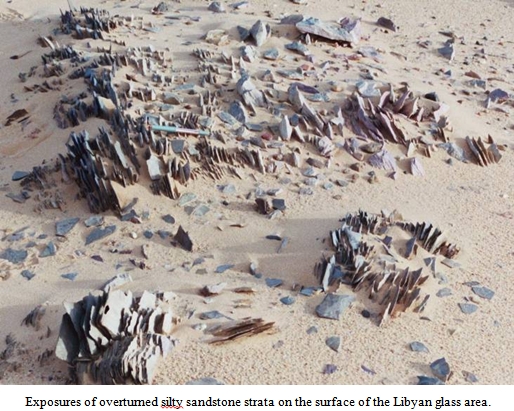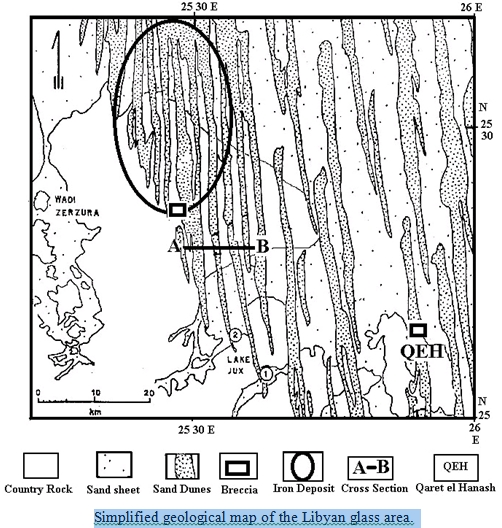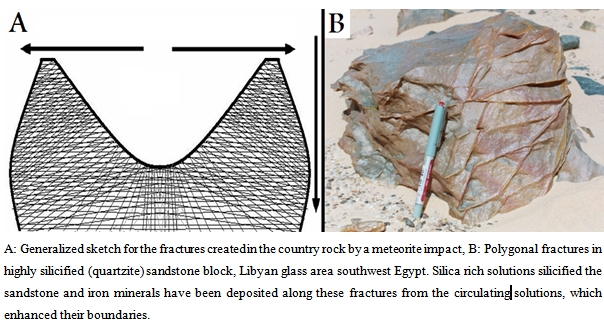Aly A. Barakat
In addition to the several statements (since, May 1991 upwards) concerning the discovery of the meteorite impact features in the Libyan glass area, presented in the front of researchers who concerned with the mystery of the Libyan glass, in different meetings, conferences and in different scientific journals, the author paid attention to the meteorite impact crater in the area. Of course, readers of these features that he located in the Libyan glass area southwestern Egypt, expect that the area represents eroded complex crater (astrobleme) irrespective if it is mentioned directly or indirectly. Anyway, the author much early describe the astrobleme of area in the Ph.D. Thesis (2004), which part of it has been published in the book entitled: “meteorite impact signs in the Libyan glass area, southwestern Egypt (2018)” and in the book entitled “the precious gift of meteorite and meteorite impact processes (2012)”, considering Qaret al Hanash Hill of being representing eroded remnant of the southeastern rim of the crater. The following passages will be quoted from the mentioned studies.
The complex meteorite impact crater of the Libyan glass area:
From the conclusion of the Ph.D. thesis (2004) and the book of 2018, we will find the author establishing the nature of the expected crater, as follows, “Seebaugh and Strauss, (1984) suggested that the formation of Libyan glass may be connected with the direct impact of a small icy comet (200-300 m diameter; 1g/cm3 density) into the area excavating a small crater (~3 to 6 km diameter). However, a weak cometary body is unlikely to have survived passage through the atmosphere (Melosh, 1989). Accordingly, the expected impactor must be larger than that suggested by Seebaugh and Strauss, (op. cit.), which suitable with the formation of a large crater. Unfortunately, there is no clear crater form in the area to be recognised easily or detected by satellite images. However, based on the field observations, which indicate central uplift, the presence of Qaret el Hanash Hill on the southeastern corner of the area, the main distribution of the glass fragments, the detection of two sites of megascopic breccias and the site of the reported diamond, one can suggest that the area includes relics of an eroded crater (astrobleme). The major axis of this crater trends WNW-ESE from Qaret el Hanash on the southeastern corner of the area to the northwestern corner of the area. Qaret el Hanash may represent remnants of the eroded southeastern rim of the crater. The petrographical and chemical studies carried out in the present study support such view. However, it is worthy to mention that this is not a final poof on the crater in the area. Further field study is strongly recommended to verify this clue.
From the book entitled:” “the precious gift of meteorite and meteorite impact processes (2012)”, we will find the following description of the crater: In fact, there is sufficient evidence supporting the view that Libyan glass formed from impact of huge celestial body with the ground. The event created large cavity in the sandstone bedrock. Large mass of the molten material (glass) covered the inner crater walls as well as the bottom of the crater. The shaped crater was of approximately 45 km diameter. Judging from tracing in situ impact breccia, at the present day Qaret el Hanish (96 m above the general desert level), on the southeastern border of the region, passing via the central uplift (hill in the center of the area of nearly 30 m high) toward the northwestern concentration of the iron deposit, the Libyan glass area is an astrobleme. Recent studies identified the necessary features for such consideration. Planar deformation features within the quartz grains of the sandstone bedrock, meteorite impact deformation of the sandstone bedrock and geological features characteristic of meteorite impact processes. In addition, medium-seized gravel diamondiferous material was detected from the area, which indicates hypervelocity meteorite impact. In line with these discoveries, relatively high Ir content (1.6-2.1 ppb), as well as Fe-Cr-Ni particles within sandstone breccia from the area indicating meteorite impact event. The absence of well-defined meteoritic crater(s) at the area can be attributed to the terrestrial processes acting on the region, since the impact event had took place until the present day. Considering the long age formation of the Libyan glass (28.5 million years), it can be easily accepted that the crater resulted from the impact event had been eroded and obliterated. This region which has been subjected to the action of the strong winds in the present time, and the water in the past (consider the shape of the outer cliffs of the Gilf Kebir plateau to the south of the area). There are also specific features in the area itself supporting such claim. The residual hillock in the center of the area represents remains of an eroded central uplift, recording overturned silty sandstone strata in the area as well as post impact hydrothermal mineralization. Unique polygonal mineralized fractures are traced in the silicified huge sandstone looms in the area. The crater had been gradually decomposed, and the glass sheets and lenses disintegrated to the present day fragments occurring on the surface of the ground. The huge meteorite impact may cause regional effects, as several species disappeared from North African regions at the same time of the event; including Aegyptopiththecus disappeared in that period.
The study (2004, 2012) describes the central uplift of the crater along geological cross section, and petrographical investigations of the rock-forming the central uplift, which shows clear concussion fractures. “At latitude 25 17′ N and longitude 25 36′ E, the basal sandstone rock intrudes the overlaying sequences and protrudes as hillocks of about 30 m above the surrounding desert level. This feature represents a central uplift indicating complex meteorite structure.
Melosh, H.G. (1989): Impact cratering. Oxford University Press, New York, 245 pp.
Seebaugh, W.R. and Strauss, A.M. (1984): A cometary model for the source of Libyan Desert glass. J. Non- Crystalline Solid, vol. 67, p. 511-519.

Exposures of overturned silty sandstone strata on the surface of the Libyan glass area.

Simplified geological map of the Libyan glass area.

Sketch of a geological cross section (A-B), through the western side of the central part of the rea, showing the central uplift.

A: Generalized sketch for the fractures created in the country rock by a meteorite impact, B: Polygonal fractures in highly silicified (quartzite) sandstone block, Libyan glass area southwest Egypt. Silica rich solutions silicified the sandstone and iron minerals have been deposited along these fractures from the circulating solutions, which enhanced their boundaries.